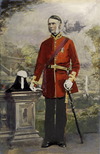BARLOW, ROBERT, cartographer and topographical draftsman; b. 18 Feb. 1813 at Margate, England; d. 16 Feb. 1883 at Montreal, Que.
Robert Barlow’s career began with the Ordnance Survey of Great Britain with which he served, probably as a civilian, for 27 years. For the last five of these he superintended a survey district in the Isle of Lewis before coming to Canada with his family in 1855. He was recruited for the Geological Survey of Canada by William Edmond Logan*, the survey’s founder and first director; Barlow received his permanent appointment as chief draftsman in June 1856. In November of that year his eldest son, Scott, was taken on as his assistant.
Barlow’s chief contribution to the survey was his role in the production and preparation of topographical maps for its reports and publications. Considering the lack of adequate topographical maps at the time on which to enter the large quantity of geological detail being collected in the field, Barlow served an important function. His greatest work was the Geological map of Canada which bears the date 1865. Engraved on steel on a scale of one inch to 25 miles, it was, according to geologist Frank Dawson Adams*, “considered one of the finest maps of the kind . . . published in any country up to that time.” It was exhibited at the Paris Exhibition of 1867, where it was awarded a prize. A reduced version, on a scale of one inch to 125 miles, had appeared in the atlas that was published in 1865 to accompany the monumental 1863 Report of progress of the survey.
Barlow was also responsible for the topographical drafting of the first of a series of maps, on the scale of one inch to four miles, which have since formed the basis of the survey’s mapping enterprise. The project was announced in the 1863 report and the first map was planned for the Eastern Townships, Canada East. Barlow assembled data from a wide variety of sources, using boundary surveys, Crown Lands Department records, and maps of the British American Land Company. This map was finally published as a topographical map by private companies, in Toronto in 1875 and in Montreal in 1883, without acknowledgement of Barlow’s work. Logan had intended him to prepare a geological map as well but, after Alfred Richard Cecil Selwyn* took over as director of the survey in 1869, Barlow was assigned to other work and the addition of geological features was postponed indefinitely. The decision not to produce the geological map, caused by the controversy surrounding Logan’s interpretation of the Quebec group of strata, became a source of bitterness at the survey, as an 1884 parliamentary investigation of the organization revealed.
On 20 June 1880, a year before the office of the survey moved from Montreal to Ottawa, Barlow retired. He and his long-time colleague, James Richardson, were the first to take advantage of the civil service superannuation benefits which in 1877 were extended to all permanent employees of the survey under an act of 1870. Although Barlow apparently shared to some degree in the grievances voiced by the survey staff in this period, he retired gracefully with none of the public reluctance displayed by Richardson. Barlow died three years later in Montreal.
Three of his sons followed him into the survey and related fields. Scott succeeded him as chief draftsman and held the post until his own death in 1894. John Rigney trained with his father and spent three years with the survey before beginning a career with the city of Montreal; he became city surveyor in 1900. A third son, Alfred Ernest, worked for the survey from 1883 to 1907 and achieved some prominence in Montreal as a consulting geologist.
Barlow’s most significant contribution to the survey was in the area of cartography. His importance is best stated by a fellow employee, Robert Bell*, who referred to him as “probably the best topographical draughtsman in the Dominion, so far as we are aware,” yet Barlow seems to have been one of those people who existed inconspicuously, leaving little trace although pursuing a useful life.
Robert Barlow prepared the Geological map of Canada . . . (n.p., 1865).
Can., House of Commons, Journals, 1884, app. 8: 66, 70, 83, 103–4, 117, 119, 165–67. Geological Survey of Can., Report of progress from its commencement to 1863 . . . (Montreal, 1863), xiii; Report of progress from its commencement to 1863, atlas of maps and sections . . . (Montreal, 1865); Report of progress from 1866 to 1869 (Montreal, 1870), 1; Report of progress for 1870–71(Ottawa, 1872), 9–11; Report of progress for 1871–72 (Montreal, 1872), 14; Report of progress for 1875–76 (n. p., 1877), 31; Report of progress for 1879–80 (Montreal, 1881), 9. Free Press (Ottawa), 17 Feb. 1883. Dominion annual register, 1883. F. D. Adams, “The history of geology in Canada,” A history of science in Canada, ed. H. M. Tory (Toronto, 1939), 7–20. T. C. Weston, Reminiscences among the rocks in connection with the Geological Survey of Canada (Toronto, 1899). Zaslow, Reading the rocks, 88–89, 124.
© 1982–2024 University of Toronto/Université Laval
Cite This Article
William E. Eagan, “BARLOW, ROBERT,” in Dictionary of Canadian Biography, vol. 11, University of Toronto/Université Laval, 2003–, accessed April 20, 2024, http://www.biographi.ca/en/bio/barlow_robert_11E.html.
The citation above shows the format for footnotes and endnotes according to the Chicago manual of style (16th edition). Information to be used in other citation formats:
| Permalink: | http://www.biographi.ca/en/bio/barlow_robert_11E.html |
| Author of Article: | William E. Eagan |
| Title of Article: | BARLOW, ROBERT |
| Publication Name: | Dictionary of Canadian Biography, vol. 11 |
| Publisher: | University of Toronto/Université Laval |
| Year of publication: | 1982 |
| Year of revision: | 1982 |
| Access Date: | April 20, 2024 |









